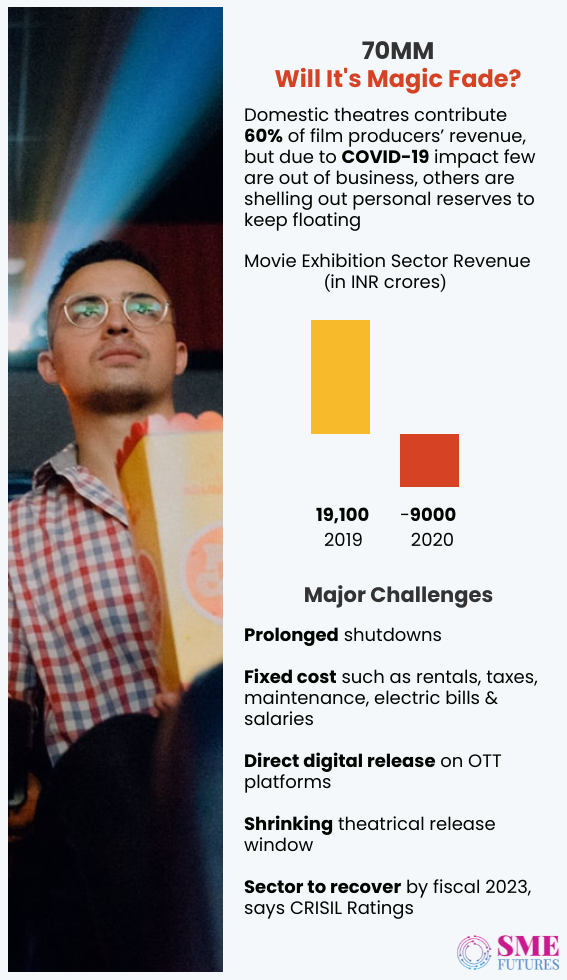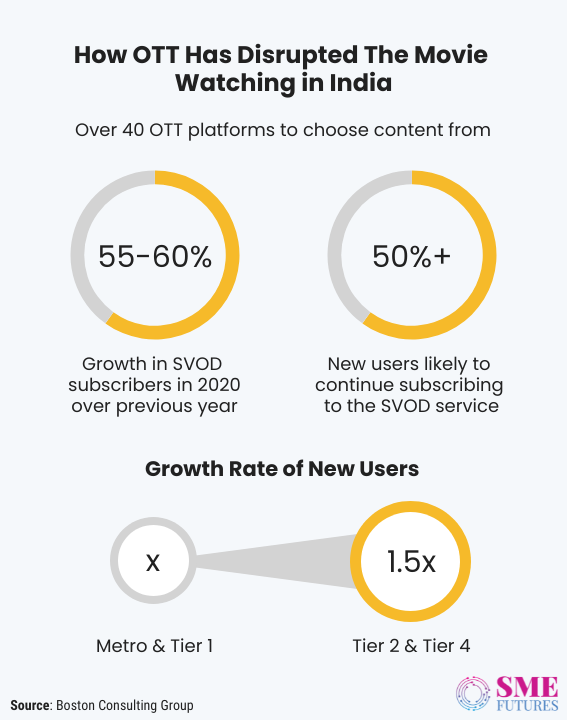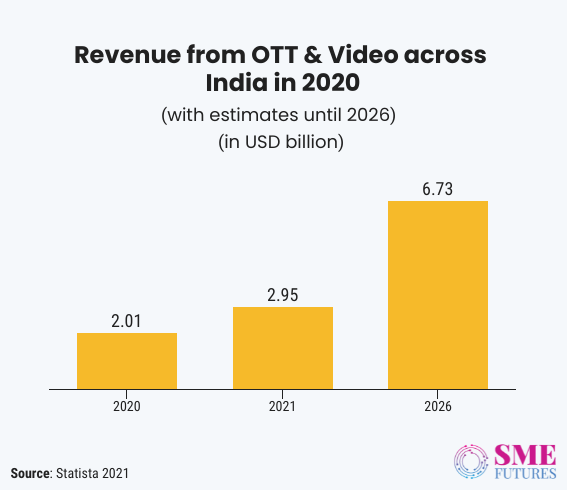January was a festive month for ardent devotees of Thalapathy, a moniker that has been bestowed upon Tollywood superstar Vijay by millions of his adoring fans.
Despite multiple COVID advisories, hardcore fans thronged the theatres near them, just to buy tickets days ahead of the release of his movie ‘Master.’ The same scene was witnessed at almost every theatre in Tamil Nadu and Kerala. The tickets were done and dusted in just ten minutes.
On the day of the release, frenzied fans celebrated the movie by dancing on the streets and showering milk on the cut-outs of their favourite star. In 20 days, Master collected Rs 200 crore worldwide.
The revenue surely was not entirely enough for the worst-hit entertainment industry to anticipate a slight revival in their fortunes, but it did not let them down either, indicating as it did that the era of theatres was not over yet.
Even the experts that we spoke to agreed, pointing out however that the impact of the pandemic on the movie industry, particularly the exhibition side of it has been seismic, and there are several reasons for this.
Theatres are bearing the brunt
2020 was one of the toughest years for the movie industry across the globe, the Indian film industry being no exception to that.
As soon as the pandemic arrived, 95 per cent of cinemas, roughly 10,000 were closed to restrict the spread of the virus. The owners of these cinema halls and multiplexes assumed that these measures would last for just a short while. But the lockdown continued to expand over the course of the year, leaving them financially unequipped to bear the costs of the almost total shutdown of their businesses.
Even after the resumption of normalcy in October 2020, there was no respite for them, as there were no major Bollywood or Hollywood film releases in Q4 FY’21, though several films from the south did rekindle some hope for a recovery. To make matters worse, the resurgence of COVID 2.0 led to cinema closures yet again. And things were far worse for single-screen theatre owners.
As for the multiplex operators, they too are facing dark days ahead.
After facing huge losses, PVR Ltd recently reported a consolidated net loss of Rs 289.12 crore in the quarter ending March 2021. The company had posted a net loss of Rs 74.49 crore in the same quarter of the last fiscal year.
Similarly, for Inox Leisure, FY21 was a complete washout. The company posted total operational revenues of Rs 148 crore with an EBITDA and PAT loss of Rs 204 crore and Rs 257 crore, respectively. According to officials, last year, 3.8 million guests visited Inox cinemas.
Besides them, some of the best in the business have burned their reserves as well.
Carnival Cinemas have not been able to keep their promises to their landlords. E Square Cinemas has let go of all but two of their 49 screens, with the remaining two on long-term lease. Then there is the SRS Cinema chain, which has 56 screens in 20 properties across 15 cities and was planning to open more before the lockdown. Many such properties are now in the grip of financial doom due to COVID-19.
The deleterious effects of this revenue loss do not stop here though as the allied players of this sector too got caught up in the dragnet of this disastrous slump.

Take the example of BookMyShow, which essentially generated its revenues through the sale of movie tickets. Its parent company, Big Tree Entertainment, saw net sales fall by 8.73 per cent to Rs 517.6 crore for the financial year 2019-20, compared to the previous financial year. While their loss window widened by 62.2 per cent to Rs 134.7 crore for the financial year ending March 31, 2020. Besides that, the company laid off several hundred employees on the back of the COVID slump. But to survive, they pivoted to transaction-video-on-demand (TVOD) services.
“It is a sad state of affairs,” said Dr. Mukesh Sharma, Dean, SoBA at NMIMS University after assessing the impact of the pandemic on the business of movie halls.
“The coronavirus pandemic has scripted a tale of extraordinary challenges for the cinema business which has come to a grinding halt since 2020. While there are no exact figures, the estimated losses could be in the ‘thousands of crores’ and the single screen theatres would have lost anything between Rs 25 to Rs 75 lakh a month,” he said.
Jehil Thakkar, partner and media & entertainment industry leader at Deloitte India sums it up in his commentary, “The theatrical business in India, that forms the main revenue source for most films, has dropped to a trickle and is likely to remain there for the short term. While the majority of the box office revenue in the country is generated now through multiplexes, single screens do remain a critical part of the distribution chain. The COVID-19 related lockdowns have hurt this part of the value chain much more than the multiplexes, which tend to be part of more resilient larger organisations. Many of these single screens and a few independent multiplexes may not ever open again. We lost a few in 2020 and we may lose some more in 2021.”
Just to give you an idea, the movie exhibition sector might have lost around Rs 9,000 crore in the first six months of the 2020 lockdown, according to the Multiplex Association of India (MAI). Whereas an analysis by Ernst & Young estimates the loss to be around Rs 7,600 crore from Rs 19,100 crore in 2019. Meanwhile, several lakhs of people have lost their jobs.
The audience shifts to OTT
Watching a movie out in a theatre was an event for us, but that’s no longer the case, thanks to the pandemic.
With the shutdown of cinemas, OTT platforms have emerged as a silver lining in the current scenario. Taking advantage of the opportunity, OTT platforms have multiplied and grown as a separate market. Their subscription grew by 55 to 60 per cent during this period.
NMIMS’s Sharma too thinks that the lockdown has boosted home TV and OTT viewing, he says, “This has resulted in the strengthening of the digital platforms, also called ‘Over the Top’ or OTT, since they bypass cable and satellite. Also, the choice and diversity of the content on these platforms is much greater.”
Now there are over 40 OTT platforms to choose from, where people are binging on movies, series, and whatnot. Talking about their market growth, ResearchAndMarket estimates that the Indian OTT sector would reach US$ 5.12 billion by 2026, growing at a CAGR of 29.52 per cent from FY2021 to FY2026.
Another sensible reason for the shift of viewers to OTT is the dry spell in the film industry. With the production of movies and projects halted, fresh movie releases are on hold, but streaming platforms are not stopping at anything to entertain us. Besides showing Indian movies, they have also brought global content to us, all the while producing their own original content as well, which is crisp and snackable.
The times seem exciting for the streaming market, indicating that the OTT market will be dominant post-COVID as well. However, the debate has now shifted to the topic of the co-existence of the cinema and OTT sectors. Industry expert Ram Jalan, erstwhile CMO at the Wave Group calls it an irreversible shift, “India is witnessing a shift in content consumption mainly because of OTT and other streaming platforms and the lockdowns at the same time,” he said while speaking to SME Futures.
While mavens like Thakkar talk about the concerns of the industry, which is apprehensive about this shift in viewership. In his view, consumers are making judicious choices about what kind of films they want to consider viewing in the theatres. He opines, “A larger than life, star led film is more likely to draw an audience rather than a dialogue-based comedy or drama – which consumers may prefer to watch at home. This change had already been in the process in large markets like the US and had begun to make its presence felt in India too.”

Direct digital releases are threatening theatres
Owing to the popularity of streaming platforms, film producers are now opting for direct digital release, also known as DDR, rather than a theatrical premiere for their films. According to experts, movie producers who are concerned about their projects have lost their patience and are releasing them on streaming platforms.
Jalan comments on this, “Cinema halls act as distribution channels, bringing in revenue at the box office, but for a long time all films releases were on halt. Today, the OTT space is giving tough competition to cinema owners. Now, movie producers are seeing value and witnessing reasonable success in releasing movies directly over OTT, especially the low budget ones. One such movie is Gulabo Sitabo which did fairly well on OTT. I mean to say, if that movie had been launched in a multiplex, it would not have done better.”
Ram Jalan, an industry expert
Simply put, direct digital release has given filmmakers the opportunity to recoup the profits that they previously thought were lost due to the lockdowns.
In general, the film producers or distributors sign a revenue-sharing agreement with theatre owners. Through this collaboration, film producers earn profits through box office receipts (BOC).
But this is not the case with DDR.
Here, exhibition rights are sold on a cost-plus basis and may result in higher opportunity costs for film producers if the movie could be a blockbuster hit in theatres.
Considering that movies are making money with the pay per view system, film makers are readily opting for the streaming platforms. Lately, from Akshay’s Laxmmi Bomb to Varun’s Coolie no. 1 to Salman’s Radhe, many movies have been released and premiered on OTT screens only.
“In my opinion, small budget movies will continue to go on OTTs and the multiplexes will miss out on getting the premiums from these movie producers,” said Jalan.
Also weighing in with his thoughts, Sharma has a very different perspective pertaining to the challenges that producers are facing. He says, “A cinema hall has to cater to the mainstream audience for commercial reasons, due to which deserving films often miss out on regular time slots. They are released as morning or noon shows. OTT platforms do not have to deal with these concerns. Even censorship is not an issue and commercial films are now being released on this media carriage. That’s why movies are going to digital channels.”
However, this change has only served to discourage cinema operators not only in India, but around the world.
When Warner Brothers announced that it would release its entire 2021 slate on digital channels, theatre owners were quick to criticise it as a move to bypass traditional theatres, resulting in a loss of profits. This move appears to some to be a ploy by Warner Bros. to make the temporary COVID accommodations permanent.

Shrinking theatrical window
Prior to the lockdowns, movies were given an exclusive theatrical window, with timelines varying globally based on geolocation. Almost all Indian films have a 6-to-8-week window before being released on digital platforms.
However, the duration of this window has recently been shrinking.
This trend came to everyone’s attention first when the Tamil film ‘Master’, dropped digitally within days of its release in January. In fact, another Tamil film, ‘Aelay,’ ran into trouble when theatre owners opposed its producer’s plan to release the film on OTT within a short period of time after its initial release in theatres. However, the plan was changed to a direct television premiere.
While in some instances, the windows are entirely eliminated, like Radhe releasing simultaneously on Zee5 and in worldwide theatres which were allowed to open.
Experts say that the pressure to release capital and the escalating costs are pushing producers to explore all possible release windows.
According to Rajender Singh Jyala, Chief Programming Officer at INOX Leisure, stakeholders are deviating from the theatrical windowing system due to the prolonged closure of cinemas. He told the media, “Any movie, which skips a theatrical release, impacts the commercial value chain in a substantial manner, from its overall collections perspective. We are confident that once we return to normalcy with all states allowing cinema operations and full capacity seating, producers will continue to follow the usual windowing pattern.”
Others are of the opinion that this is due to the increased pressure from OTT players, who appear to be battling each other over content.
Meanwhile, players like Netflix are quite enthusiastic about the shrinking theatrical window. In an interaction with TheWrap, a Hollywood news portal, a Netflix official says that it is what consumers want and it is hard to buck that trend for too long.
But the big screen is here to say
Even though these are challenging times for film makers and exhibitors, the charm of the big screen is never going to fade, conclude most of the industry experts.
“People will certainly come back,” says Jalan. “After some time, people want to go out. They want to have an experience and cinema halls are all about having a good time with family and friends in a group,” he avers.
Sharma also adds, “The lockdown will finally be over at some point in time… since going to a movie theatre is not just about watching a film but is also an outing, a picnic, for the entire family, cinema will come back.”
Having said that, some movies are best enjoyed in theatres, with 70mm screens and Dolby digital surround sound, which feels unparalleled.
However, the screen operators are certain about one fact-theatres and the multiplex sector will transform in a big way and for the better.
According to Jalan, watching movies in cinema halls in the future is going to be more expensive and there are reasons for that. “There would be inherent safety concerns among the audiences certainly, to go and watch movies sitting neck to neck with each other. And that’s why for maintaining SoPs, cinema halls must create more space for the audience to sit, which will be costly, and therefore the ticket prices will go up,” he says.
For the future, cinema chains are moving towards premiumization with better screens, broader F&B menus, and convenient booking options to make movie watching a more engaging and immersive experience.
A single screen exhibitor in Bihar, Vishek Chauhan, talking about the future of cinema in a YouTube video says, “Premium format cinema or PLF or Imax is going to be a more prominent format. You will find a specific number of chairs with spacious seats such as sofas or recliners inside a movie hall. Besides that, in the future, I fathom that there will be more amenities around food and the cafeteria, such as one can have lunch, high tea, dinner or eat from a buffet within a bundle price with the tickets.”
Sharma adds another interesting point of view, “Open-air cinema halls or drive-through theatres may see the light of day again, which were in vogue during the 80s,” he says.
This reflects more on the comeback of the single screens, even though presently they are the ones taking the most heat due to the pandemic. However, after some time people would prefer watching movies in a cinema near them, closer to their locations, asserts Jalan.
According to Jalan, “What I see is, that a lot of standalone movie multiplexes will mushroom, not within the malls but as a separate property. And it is not a new format as there is a pre-existing culture of single screen theatres which got deserted after the malls and multiplexes came together. Now, I believe that the single screen will be back in business due to the shift that we are witnessing.”
Cinema pundits too are predicting a coexistence of the big screens and OTT, instead of the streaming platforms taking over the movie halls. But we cannot deny the fact that the OTT platforms have gradually created a disruption in the content creation space, with strong, edgy, gritty narratives aimed at engaging a specific target audience. As a result, the overdependence on star driven vehicles is also waning.
Today there is a lot more content diversity.
OTT budgets are expanding. Small, offbeat films or out of the ordinary content now have a chance. However, it is all entirely dependent upon the audience.
Consumers are discerning and can switch anytime from one type of content to another. Quality is what matters nowadays, be it of a series, a film, or a reality show. On the other hand, large-budget films naturally lend themselves to the big screen. Having said that, there will always be a market for lavish blockbusters. Good content will eventually have the final say on both the big and small screens.
At the same time, according to Crisil Ratings, a full recovery for multiplexes is not expected until fiscal year 2023. Till then, movie theatres, mostly single-screen operations, will have to endure and embrace the change, as well as transform themselves, in order to survive.










